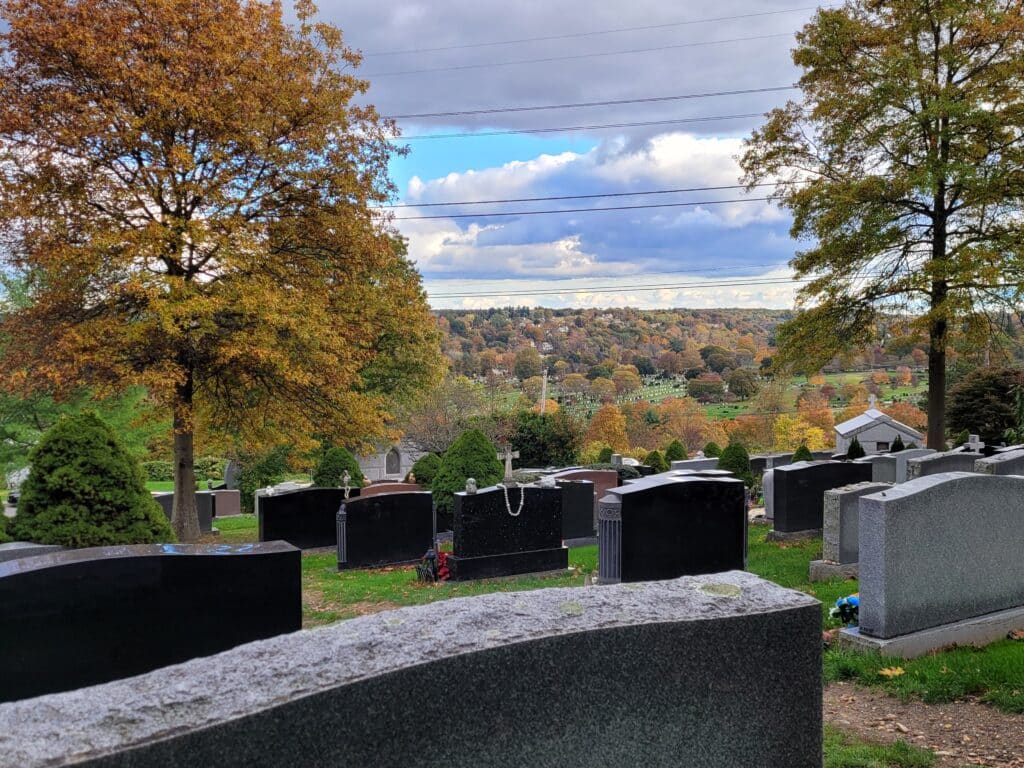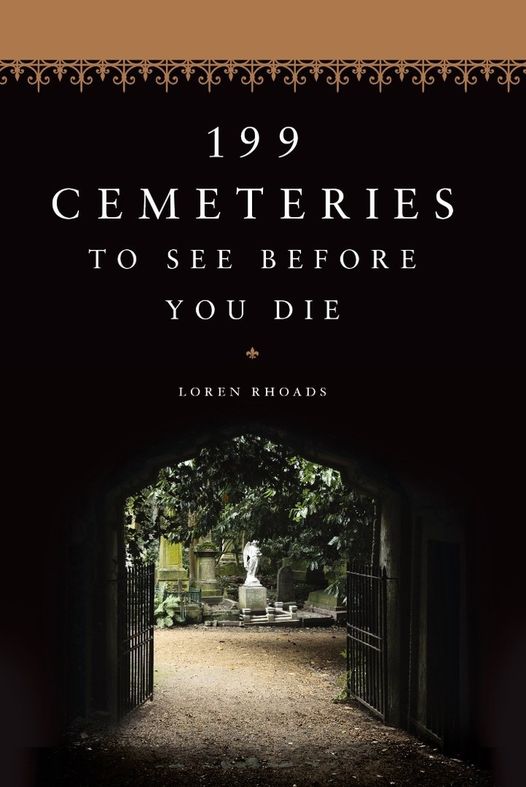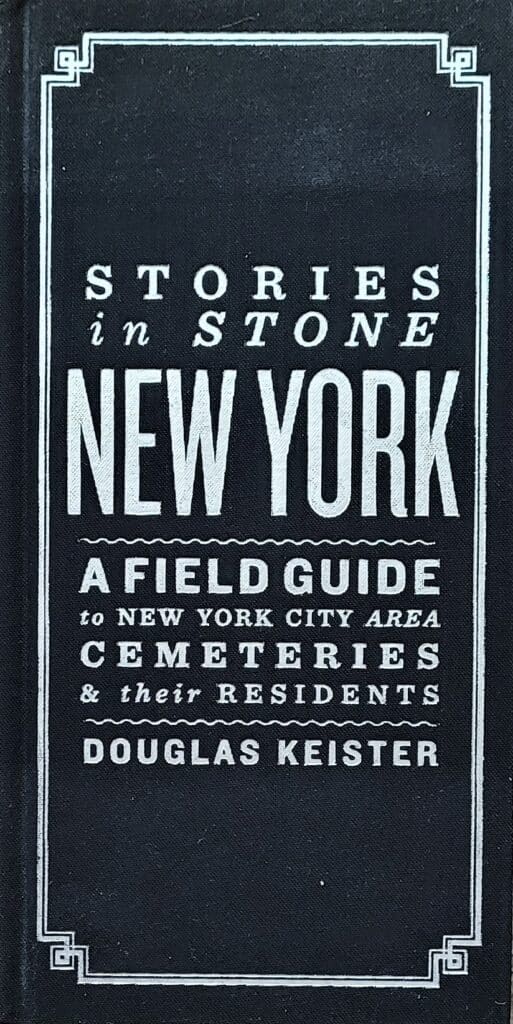
My Favorite Cemetery Travel Books
Autumn. A time for pumpkin picking, hayrides, apple cider – and exploring cemeteries.
There’s an energizing crispness in the air, and the cooler temperatures are perfect for long walks. In fact, taphophiles (cemetery enthusiasts) will tell you that the fall, with its cornucopia of vibrant colors, is prime time to rediscover (or discover for the first time) some of the history to be found in the world’s cemeteries.

Tombstone tourism has become an increasingly popular pastime. Loren Rhoads, the author of the popular book 199 Cemeteries to See Before You Die, lays out a number of the reasons why.
“If you’re interested in genealogy you, can connect with your ancestors. If you’re a gardener, you can smell the flowers or admire a specimen tree. If you’re a birdwatcher, cemeteries are often places for migrating birds. You can see one-of-a-kind statuary, or world-class stained glass. If you’re interested in history, there’s plenty to find in cemeteries. If you are inspired by a particular author or an actor or musician, you can pay your respects at their graves.” What’s more, she adds, “There’s a lot to be said for having a quiet moment of contemplation or some time to enjoy some sunshine and blue sky.”
As a self-described history geek and cemetery book author (Gardens of Stone and Green-Wood Cemetery) myself, I agree with all that Rhoads has said. Exploring these historical repositories is an engrossing interest of mine. And bringing along a compact and portable cemetery guidebook makes the visit extra-special. Keep in mind, even if you can’t visit in person, you can take a satisfying armchair tour through the pages of these books.
Here are some of my favorites.
199 Cemeteries to See Before You Die by Loren Rhoads

The catchy title drew me in right away, and the pages that followed lived up to my expectations. The book is wide in scope and includes cemeteries from around the world, along with their websites. Australia, Africa, Asia, Canada, Europe, the Middle East, and Central and South America are all represented. Rhoads, who has visited more than 60 of the cemeteries she wrote about, also included popular tourist sites such as Petra, Pompeii, and Egypt’s Valley of the Kings.
With less of a focus on celebrity graves, the book is filled with color photographs. They often depict the seldom-noticed gravesites of the unsung, such as the race car replica that marks the grave of 17-year-old Joey Laquerre, a fourth-generation race car driver, in Vermont’s Hope Cemetery.
Rhoads grew up on a farm near a cemetery that she enjoyed visiting as a child. “It had lamb markers and a six-foot tree stump with calla lilies,” she recalled. But she believes it was the visits she took with her parents during family vacations to such historic sites as George Washington’s grave at Mount Vernon and the Kennedy graves at Arlington National Cemetery that opened her to the idea of visiting cemeteries. However, she said, “it took visiting Highgate Cemetery in London for me to fall in love with them.”
Rhoads began writing about cemeteries in 1994 when she edited the book Death’s Garden: Relationships with Cemeteries. That led to a monthly column about visiting cemeteries for an online magazine.
“Some of those columns became my cemetery memoir Wish You Were Here: Adventures in Cemetery Travel.” They also led to her blog. So, in 2016, when a publisher contacted her to see if she was interested in writing a book for them, she had more than enough material. It was then that she pitched 199 Cemeteries to See Before You Die.
Stories in Stone: A Field Guide to Cemetery Symbolism and Iconography by Douglas Keister

Douglas Keister may just be the master of the genre, leading the way for other cemetery book authors. Stories in Stone: A Field Guide to Cemetery Symbolism and Iconography, published in 2004, was the first in the aptly named “A Field Guide” series. The book is a primer on the varied symbolism to be found in cemeteries all over the world.
Far beyond the religious symbolism we expect to see, the book includes depictions and explanations of lesser-known symbols of memorialization, flora, fauna, and fraternal organizations, as well as types of funerary architecture. And what they denote can often tell a lot about the deceased.
Four years later, Keister wrote Forever Dixie: A Field Guide to Southern Cemeteries & Their Residents. The book features 12 southern cemeteries, including the hauntingly beautiful Bonaventure in Savannah, Georgia, and includes such notable names as Colonel Harlan Sanders and country music greats Tammy Wynette and June and Johnny Cash.
The Dixie guide was followed by a series of other books: Forever L.A.: A Field Guide to Los Angeles Area Cemeteries & Their Residents (2010); Stories in Stone: New York: A Field Guide to New York City Area Cemeteries & Their Residents (2011); and Stories in Stone Paris: A Field Guide to Paris Cemeteries (2013) which includes the storied Père-Lachaise, the most visited cemetery in the world, in which Oscar Wilde, Molière, Frédéric Chopin, Sarah Bernhardt, and rock star Jim Morrison permanently reside.
Where Are They Buried? How Did They Die? by Tod Benoit

At more than 500 pages, each new edition of Tod Benoit’s book is comprehensive. The encapsulated biographies engagingly answer the title’s questions and provide readers with little-known facts about the lives of the subjects.
In addition, there are helpful directions to not only the cemetery but also to a particular gravesite. It’s worth noting that Benoit’s first job, at 14, was cutting the grass at his hometown’s cemetery.
Originally published in 2003, there have been updates to the book in 2010, 2014, and 2019.
“Each edition has a freshness due to there being a number of new recent deaths of famous people,” said Benoit.
Unlike most cemetery compendiums, Benoit’s book is arranged by genre instead of by cemetery. Chapters include Baby Boomer Icons (Elvis Presley, Charles Schulz, John Lennon); Senior Memories (Norman Rockwell, Jack Benny, Humphrey Bogart, Burl Ives, Groucho Marx); Original Women (Princess Diana, Billie Holiday, Mother Teresa) and Notable Figures from History (Martin Luther King Jr., Oskar Schindler, Harriet Tubman, and Sigmund Freud).
When choosing who will be selected, Benoit explained that “generally, it has to be someone who, for better or worse, made a difference in the fabric of American culture.”
Benoit also devotes a chapter to help readers find where someone is buried. He assures readers that “With persistence you can find just about anyone’s grave.”
A fifth version of the book will be released in April of 2023. Updates include the gravesites of such cultural icons as Alex Trebek, Regis Philbin, Hank Aaron, Olivia Newton-John, and Betty White.
Let’s Have a Conversation:
Have you considered taking a walk in your local – or a famous – cemetery? What would take you there and would you look for a specific person’s grave?
Tags Books






